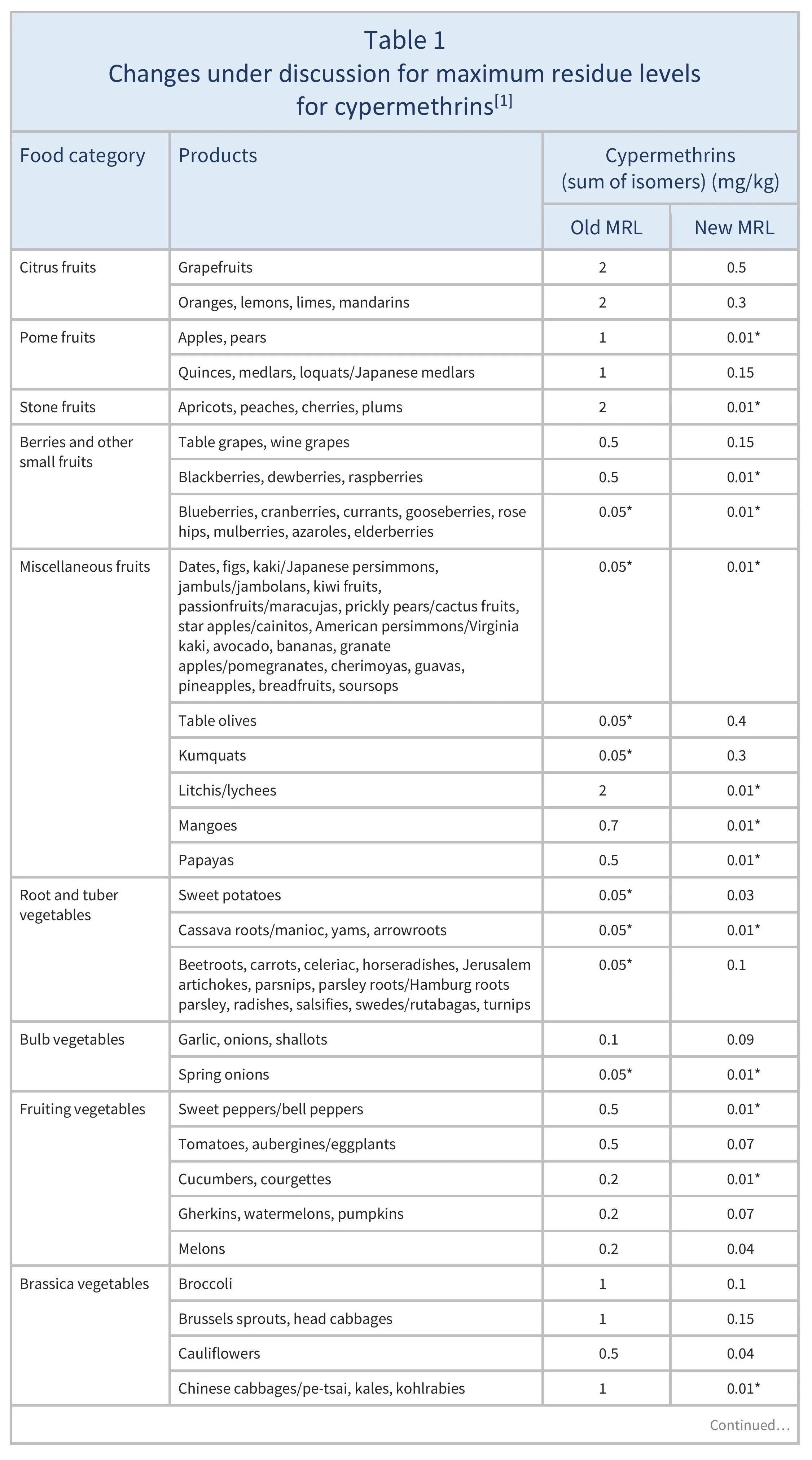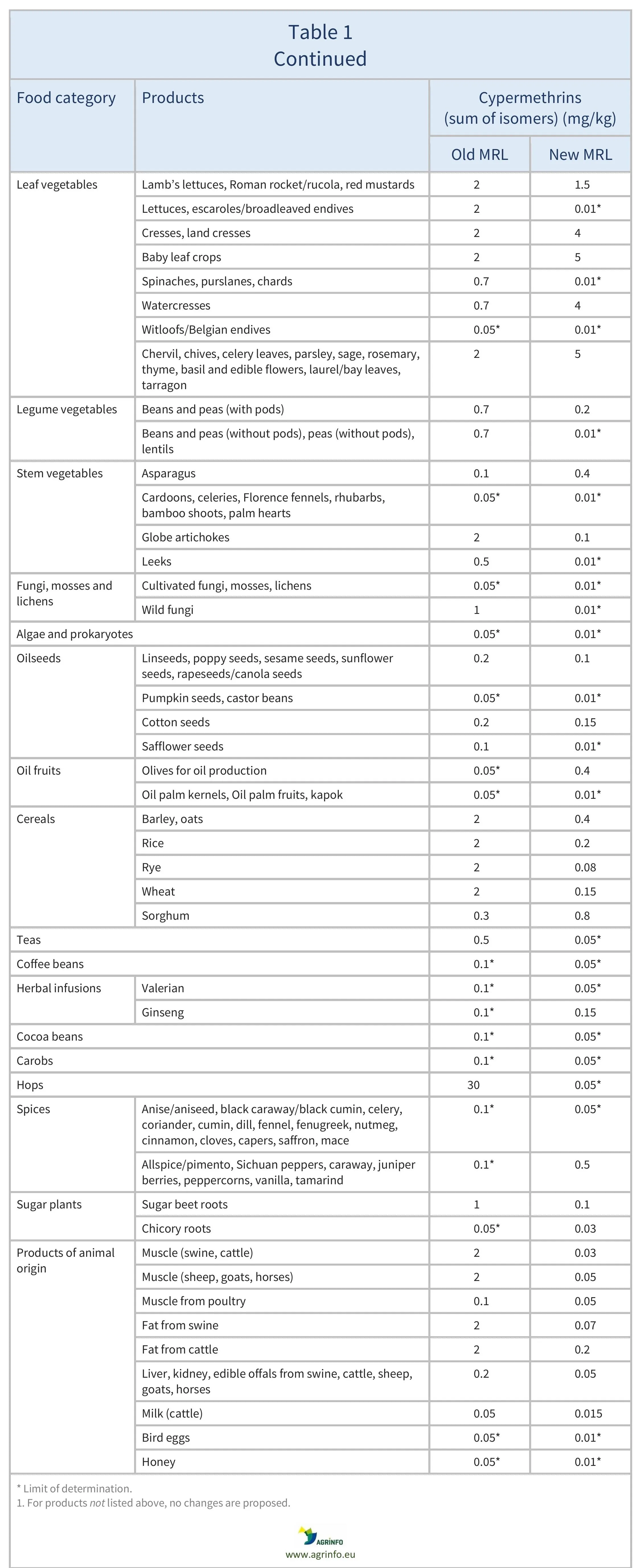Maximum residue levels for cypermethrins
- Food safety
- Pesticide MRLs
- Pesticides
Summary
The European Union (EU) is discussing a review of maximum residue levels (MRLs) for cypermethrins (sum of isomers). The EU is also considering setting new specific MRLs for alpha-cypermethrin (see Maximum residue levels for alpha-cypermethrin).
This includes reducing the MRLs to the limit of determination (LOD) on several products (the LOD is the lowest level that can be detected using the most modern and reliable analytical methods). This could have an impact on suppliers of a wide range of products, in particular fruits (pears, certain berries, litchis, mangoes, papayas), sweet peppers, cucumbers, courgettes, lettuces, spinaches, beans, and peas.
EU discusses revision of MRLs for cypermethrins
Draft Commission Regulation amending Annexes II and III to Regulation (EC) No 396/2005 of the European Parliament and of the Council as regards maximum residue levels for alpha-cypermethrin and cypermethrin in or on certain products [download]
Draft Annex [download]
Update
The European Union (EU) is discussing a review of maximum residue levels (MRLs) for cypermethrins (sum of isomers). The EU is also considering setting new specific MRLs for alpha-cypermethrin (see Maximum residue levels for alpha-cypermethrin).
This includes reducing the MRLs to the limit of determination (LOD) on several products (the LOD is the lowest level that can be detected using the most modern and reliable analytical methods). This could have an impact on suppliers of a wide range of products, in particular fruits (pears, certain berries, litchis, mangoes, papayas), sweet peppers, cucumbers, courgettes, lettuces, spinaches, beans, and peas.
Impacted Products
Grapefruits, oranges, lemons, limes, mandarins, apples, quinces, pears, medlars, loquats/ Japanese medlars, apricots, peaches, cherries, plums, table grapes, wine grapes, blackberries, dewberries, raspberries, blueberries, cranberries, currants, gooseberries, rose hips, mulberries, azaroles, elderberries, dates, figs, carambolas, kaki/ Japanese persimmons, jambuls/ jambolans, kiwi fruits, passionfruits, prickly pears, star apples/ cainitos, American persimmons, avocados, bananas, granate apples/ pomegranates, cherimoyas, guavas, pineapples, breadfruits, soursops, table olives, kumquats, litchis, mangoes, papayas, potatoes, cassava roots/ manioc, yams, arrowroots, sweet potatoes, beetroots, carrots, celeriac, parsnips, radishes, salsifies, swedes, turnips, horseradishes, Jerusalem artichokes, parsley roots, garlic, shallots, onions, spring onions, tomatoes, sweet peppers/ bell peppers, aubergines/ eggplants, cucumbers, courgettes, gherkins, watermelons, pumpkins, melons, broccoli, head cabbages, Chinese cabbages/ pe-tsai, kales, kohlrabies, cauliflowers, Brussels sprouts, lamb's lettuces, lettuces, escaroles, Roman rocket/ rucola, red mustards, cresses, landcresses, baby leaf crops, spinaches, purslanes, chards, watercresses, grape leaves, witloofs/Belgian endives, chervil, chives, parsley, sage, basil and edible flowers, celery leaves, rosemary, thyme, laurel/ bay leaves, tarragon, beans (with pods), peas (with pods), beans (without pods), peas (without pods), lentils, asparagus, cardoons, celeries, Florence fennels, rhubarbs, bamboo shoots, palm hearts, globe artichokes, leeks, cultivated fungi, mosses and lichens, wild fungi, algae and prokaryote organisms, linseeds, poppy seeds, sesame seeds, sunflower seeds, rapeseeds/ canola seeds, soyabeans, pumpkin seeds, castor beans, cotton seeds, safflower seeds, olives for oil production, oil palm kernels, oil palm fruits, kapok, barley, oats, rice, rye, wheat, sorghum, valerian, ginseng, anise/ aniseed, black caraway/ black cumin, celery, coriander, cumin, dill, fennel, fenugreek, nutmeg, cinnamon, cloves, capers, saffron, mace, sugar beet roots, chicory roots, muscle from swine and cattle, fat from swine, liver, kidney and edible offals from swine, cattle, sheep, goats and horses, fat from cattle, muscle from sheep, goats, horses, muscle from poultry, commodities from other farmed terrestrial mammals, milk (cattle), bird eggs, honey
What is changing?
The EU is discussing the amendment of MRLs for cypermethrins (sum of isomers) on certain products, as summarised in Table 1. In addition, the EU is discussing setting specific MRLs for alpha-cypermethrins: see Maximum residue levels for alpha-cypermethrin.
Why?
Following a review of the existing MRLs for cypermethrins (“cypermethrin including other mixtures of constituent isomers: sum of isomers”), EFSA (2023) recommended maintaining or increasing these MRLs according to available good agricultural practices (GAP), or based on Codex MRLs where they are considered safe.
For certain products, risks were identified that require action (EFSA 2023). As these risks are often associated with the more toxic alpha-cypermethrin, rather than reduce cypermethrin MRLs to the limit of determination (LOD), the European Commission proposes two sets of MRLs, one for cypermethrin (sum of isomers), and a separate one for alpha-cypermethrin. This approach will allow the EU to maintain cypermethrin MRLs for many products identified as a risk, and also maintain alignment with Codex Alimentarius MRLs (CXLs) (European Commission 2024).
Timeline
This Regulation is still under discussion and is expected to be adopted in 2026.
Background
MRLs are set in accordance with the rules set out in Regulation 396/2005. For information on current MRLs for other substances, please consult the EU Pesticide Residues database.
Resources
EFSA (2023) Review of the existing maximum residue levels for cypermethrins according to Article 12 of Regulation (EC) No 396/2005. EFSA Journal, 21(3): 7800.
European Commission (2024) Standing Committee on Plants, Animals, Food and Feed (Section Phytopharmaceuticals – Pesticide Residues), 23–24 September.
Sources
Draft Commission Regulation as regards maximum residue levels for alpha-cypermethrin and cypermethrin in or on certain products [download]
Draft Annex [download]
Tables & Figures
Disclaimer: Under no circumstances shall COLEAD be liable for any loss, damage, liability or expense incurred or suffered that is claimed to have resulted from the use of information available on this website or any link to external sites. The use of the website is at the user’s sole risk and responsibility. This information platform was created and maintained with the financial support of the European Union. Its contents do not, however, reflect the views of the European Union.
EU discusses revision of MRLs for cypermethrins
Draft Commission Regulation as regards maximum residue levels for alpha-cypermethrin and cypermethrin in or on certain products [download]
Draft Annex [download]
What is changing and why?
The European Union (EU) is discussing the amendment of maximum residue levels (MRLs) for cypermethrin as summarised in Table 1.
In addition, the EU is considering setting new specific MRLs for alpha-cypermethrin (see Maximum residue levels for alpha-cypermethrin).
For certain products, risks were identified (EFSA 2023) often associated with the more toxic alpha-cypermethrin. Rather than reduce cypermethrin MRLs to the limit of determination (LOD), the European Commission proposes two sets of MRLs, one for cypermethrin (sum of isomers), and a separate one for alpha-cypermethrin. This approach will allow the EU to maintain cypermethrin MRLs for many products identified as a risk, and also maintain alignment with Codex Alimentarius MRLs (CXLs) (European Commission 2024).
Timeline
This Regulation is still under discussion and is expected to be adopted in 2026.
Tables & Figures
Disclaimer: Under no circumstances shall COLEAD be liable for any loss, damage, liability or expense incurred or suffered that is claimed to have resulted from the use of information available on this website or any link to external sites. The use of the website is at the user’s sole risk and responsibility. This information platform was created and maintained with the financial support of the European Union. Its contents do not, however, reflect the views of the European Union.


